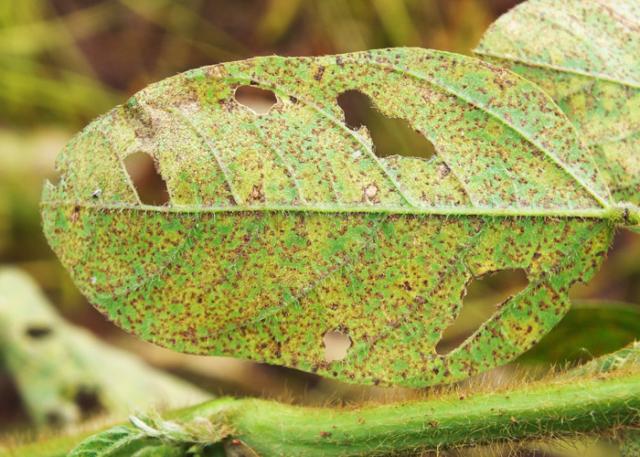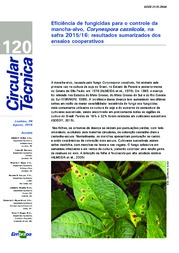Embrapa and Bayer study will map mechanism of soybean disease resistance to fungicides
Embrapa and Bayer study will map mechanism of soybean disease resistance to fungicides
Embrapa and Bayer, a German multinational company, established a partnership to study the mechanisms that cause soybean pathogenic fungi to lose sensitivity to the products currently used in the fields. Estimated to last five years, the research project aims to identify the fungi Corynespora cassiicola (which causes target spot) and Phakopsora pachyrhizi (responsible for Asian soybean rust) resistance to the fungicides available in the market. "We want to understand how and where resistance occurs in such fungi, and thus adopt antiresistance preventive actions", the Embrapa Soybean researcher Maurício Meyer explains.
One of the main goals of the partnership is to participate in the effort of sequencing the genome of the Asian soybean rust fungus, which is being led by an international consortium that comprises Embrapa, Bayer, and other research institutions from Germany, France and the United States. Based on the data generated by the P. pachyrhizi genome sequencing, the project is going to unfold in two research fronts.
On one hand, the research wants to understand the fungus' gene mutation mechanisms that provoke loss of sensitivity and resistance to the main groups of fungicides used to control the disease. In the other study section, the idea is to identify regions of the fungus' genome associated with its plant virulence, and the results could help the development of Asian soybean rust-resistant varieties.
"We will have five years to better understand the mechanisms of resistance to fungicides through the genetic mapping of the fungi. With the genome in hand, we will be able to understand how loss of sensitivity occurs, anticipate antiresistance management strategies, and develop more efficient solutions for control", explains the Bayer's Advanced Fungicide Development manager, Rogério Bortolan.
The genetic sequencing of P. pachyrhizi is a major challenge to be tacked by the project, considering the size and the complexity of its genome. At least one previous attempt to sequence and assemble the fungal genome has failed. "However, in order to advance in the development of new tools for Asian rust control, the sequencing is fundamental," Meyer stresses.
The study will be based on a standard sample of the fungus that has possibly suffered few mutations as it was not exposed to many successive fungicide applications. Then there will be a resequencing of isolates (parts of the fungus' genome) collected in Brazil and in other countries throughout the last decade that have different profiles of virulence and sensitivity to fungicides, due to their constant contact with such products.
"By obtaining the fungus' reference genome followed by the resequencing of different isolates, we hope to decipher its biology and to understand the complex interaction with host plants, and also broaden our understanding of its adaptability, evolution and genetic diversity," explains the researcher from Embrapa Soybean Francismar Marcelino. The results obtained will be published and will benefit the entire soybean production chain.
The project also intends to study the changes that occurred to the C. cassiicola and P. pachyrhizi fungi due to their exposure to different groups of fungicides. PFor that purpose, the fungi's sensitivity will be compared by opposing populations that suffered no or low amounts of genetic mutations to those that suffered selection pressure from larger exposure to the fungicides applied to the crop in the course of the last 10 years. "Then we will have parameters to identify and monitor the development of resistance to fungicides, and to verify whether new mutations are taking place," Meyer sums up.
The last stage of the study includes the mapping of Brazilian soybean producing areas at potential risk of developing resistance to fungicides. "If the study identifies that the frequency of fungal genetic mutations increased a lot in a given region, that is an indicator that the pressure for that group of fungicides is higher in the region at stake. It will be a warning sign to anticipate the adoption of antiresistance measures and prevent the loss in product efficiency," he observes. The need to change the chemical control strategy in light of the reality of each region is a way to preserve fungicides, since there are low prospects of launching new products in the market in the upcoming years.
According to the head of Agronomic Development at Bayer, Bernard Jacqmin, the study paves the way towards solving a great challenge of the industry: ensuring the sustainability of existing tools for soybean disease control. "Such cooperation with Embrapa will be essential to further the study of fungal genetics and the understanding of how resistance develops after repeated fungicide applications. The resort to an institution like Embrapa provides Bayer with backing to present the recommendations derived from the research to the sector and to farmers, especially at the time of implementing them in the fields", he concludes.
Understanding soybean rust
Asian soybean rust, the most severe disease for the crop, was identified in Brazil in the 2001/2002 harvest. The disease causes early defoliation, and compromises the formation and development of the pods and of the final grain weight. Hence it can damage up to 100% of the yield if it is not adequately managed. The average rust cost (expenses with fungicides for control + production losses) is US$ 2 billion per harvest in Brazil.
The disease control has focused mainly on chemical control. Despite the contribution from three groups of fungicides in the market, the Antirust Consortium has observed a reduction in the efficiency of these products since the 2007/2008 harvest, due to the increased frequency of mutations that reduce the efficiency of control. The fungi's resistance to fungicides is a natural process.Nevertheless, the shelf life of the chemical products can be extended with their rational use, antiresistance strategies and the adoption of best practices.
Translation: Mariana de Lima Medeiros
Lebna Landgraf (MTb2903-PR)
Embrapa Soybean
Press inquiries
soja.imprensa@embrapa.br
Phone number: (43) 3371-6061
Further information on the topic
Citizen Attention Service (SAC)
www.embrapa.br/contact-us/sac/




